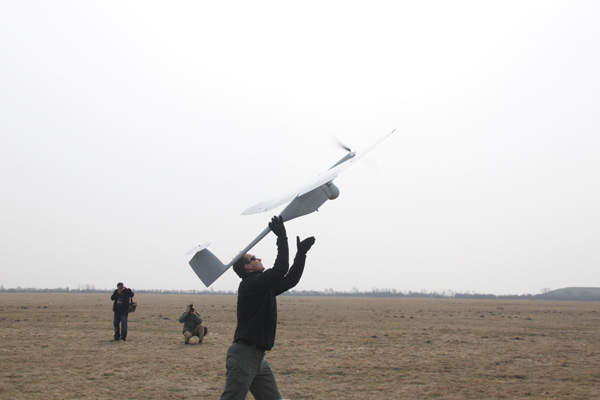Fly Eye is a mini uncrewed aerial vehicle (UAV) designed and built by WB Electronics to provide advanced aerial reconnaissance capabilities to military and special operations forces.
The UAV can be deployed to determine target coordinates for artillery operations. Identification, escorting, target acquisition, and monitoring of natural disasters and forest fires are also other uses, along with surveillance of a battlefield and national borders.
An exhibit was held to showcase the UAV at the International Trade Fair INTERPOLITEX 2013 held in Moscow, Russia. The vehicle was also demonstrated to the Polish Special Forces unit AGAT in February 2014.
Orders and deliveries from the Polish Armed Forces
The Polish Army placed a contract with WB Electronics for the supply of 12 Fly Eye uncrewed aerial systems (UAS) for air reconnaissance and destruction operations in February 2013.
WB Electronics signed a contract from the Inspectorate for Arms of the Ministry of Defense of Poland to deliver three upgraded small-size, third-generation Fly Eye UAVs for the Polish territorial defence forces in December 2018. The contract also includes an option for nine more UAVs.
The third-generation UAVs are equipped with a new optoelectronic surveillance system and a battery. The enhancements to the UAV also covered the ground control station (GCS), transceiver station, transportation cases, and backpacks.
The company delivered the first batch of third-generation Fly Eye mini-UAVs to the Polish Armed Forces in December 2018.
In July 2019, the Nato Support and Procurement Agency (NSPA) and WB Group signed a supplemental agreement for the upgrade of the existing Fly Eye UAVs. The upgrades will modernise the equipment and standardise the configuration to enhance the interoperability of the Polish Army with Nato countries.
The agreement covers repair kits, training, and ongoing maintenance services. The upgraded version features a GCS with an antenna. The reduced weight enables the UAV to operate for a longer duration on station.
Poland ordered additional Fly Eye UAVs from WB Group for $12.5m in February 2022. The additional UAVs will be delivered to the Rocket and Artillery Forces of Poland by 2023.
Fly Eye UAV design and features
The Fly Eye UAV features a compact airframe made of composite materials. Its modular structure can be easily assembled or disassembled, and it has fully autonomous take-off and landing capability. The vehicle can be deployed within ten minutes and can execute missions in confined areas.
The man-portable drone has a length of 1.9m, a wingspan of 3.6m, and a maximum take-off weight of 11kg. It can carry a maximum payload of 4kg and is carried in two backpacks.
Two people are required to operate the drone, which is hand-launched and can be recovered using a parachute. The flight route can be pre-programmed by the operator and can be modified during the flight.
A training simulator is used as part of the UAS, which educates the crew in mission planning, managing system parameters and executing missions with a simulation of flight environment. The simulator also ensures the team mimics surveillance payload control and observation of objects.
Anti-spin is installed in the UAV, in addition to anti-icing systems for improved flight safety. The vehicle can also be integrated with an SKO-M Mortar Fire Control System and a TOPAZ Automated Fire Control System to provide fire reconnaissance for artillery operations.
Communications of the Fly Eye UAV
The UAV’s communication system operates in harmonised Nato military frequency bands ranging between 4.4GHz and 5.0GHz. Meanwhile, the drone can be automatically retracted to the position of last radio contact or landed at a pre-defined point, in the event of communication loss.
The UAV is fitted with tactical and maritime antennas, as well as the emergency location and recovery device based on a global positioning system (GPS). Military standard connectors are also fitted to the UAV.
Payloads aboard the Fly Eye UAV
The Fly Eye UAV is fitted with a surveillance payload under the fuselage. This payload includes two cameras to capture video imagery in real-time and provides an improved observation range for the UAV.
The drone is attached with a computer hard drive to record telemetric data. This includes data transmission speed, time, flight altitude and coordinates of the current image, amongst other information during the flight. Reutech Communications was selected to develop the communication systems onboard the UAV.
The unmanned system also carries the GS4 daylight and infrared (IR) observation payload.
Fly Eye UAV ground control station
Two ergonomic light GCSs control the Fly Eye UAV. A mobile transceiver station is installed to facilitate communication between the vehicle and the ground control stations. It does this by transmitting video streaming generated by the air system in real-time.
A portable and compact remote video terminal (RVT) is also incorporated to receive imagery and video from the UAV. Furthermore, a digital link can be used to transmit/receive flight control missions and telemetric data.
Engine and performance
Power for the UAV is provided by an electric engine that uses lithium-polymer batteries. This engine has a speed ranging from 50km/h to 170km/h and can operate at an altitude of 1,000m above the take-off point. Its maximum altitude above the mean sea level is 4,000m.
The UAV can carry out missions for up to three hours, based on the weather conditions. It operates in temperatures varying between -20°C and 50°C and can withstand wind speeds of up to 12m/s and humidity of 95% / 50°C. Meanwhile, the drone has an estimated standard life span of 300 missions.







